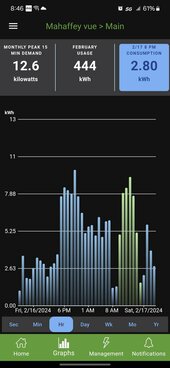vwaudiguy
New Member
I've got a 40 Jinko 410w panel with 2 Solaredge SE10000H-US grid tie inverters. I have been pleased with the system so far as it has overproduced for the year as far as KWhs and kept me paying the minimum fee of $31 for 9 months out of the year. Winter my heat pump just eats the power. Starting in April my utility company will start charging me a "Demand" fee based on the highest Kw usage in any given 15 minute period of a billing cycle.. I'm looking for a way to combat that with the system I currently have. My demand ranges from 11.5kw to 21kw. I'm thinking it may be time to add some batteries and attempt to "peak shave" a bit. I even thought about breaking some of my heavy peak, low Kwh appliances off from the main panel into a critical load panel and try to run them completely off grid. Anyone got any tips ? I use an Emporia Vue to track my usage.



